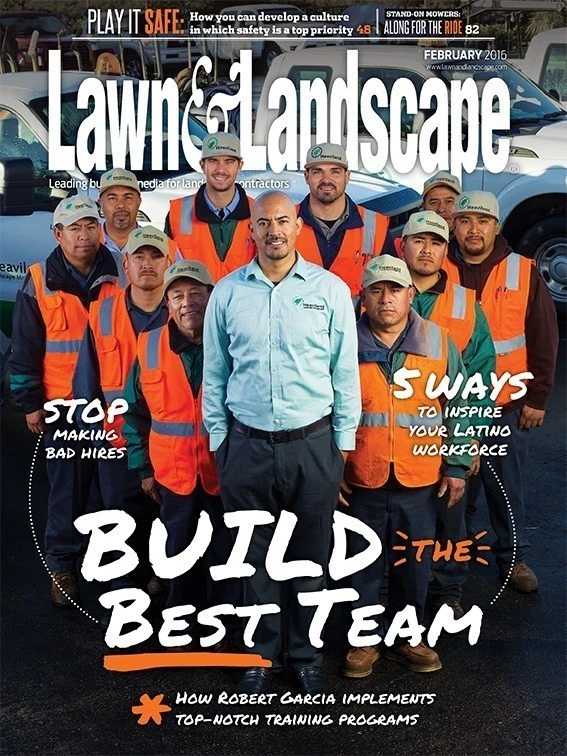
Robert Garcia spent 10 years working on landscaping crews before joining Heaviland Landscape Management in 2013. Shortly thereafter, he moved from gardener to account manager, then safety director and, ultimately, operations manager. During that first decade in the industry, though, he received very little training about how or why he should seek to move up the ladder.
Frustrating? Yes. Atypical? Nope.
“I’d been in the field for 10 years, nobody ever taught me anything,” Garcia says. “It was more focused on how to use the equipment. Sometimes employees make simple mistakes and it’s our fault because we’re not training them.”
A big change came when he attended a “Train the Trainer” conference put on by the National Hispanic Landscape Alliance and Ellen Ely, president of Landscape Training Solutions, shortly after he joined Heaviland. (See “Invest in your Latino Workforce” for more of Ely’s advice on connecting with your Latino workforce.)
Now in his new role as ops manager, he’s also in charge of developing and leading the training program for all 130 Heaviland employees throughout southern California – everything from on-boarding to weekly training for crews. We asked him for his advice on how our readers can implement real-world training at their own companies. Here’s what he said.
Consider your delivery.
Not everyone learns the same way, or at the same pace. Garcia says his younger gardeners are more technical and prefer printed handouts with information. Older employees tend to thrive with tactile training – actually touching the irrigation valves or plant material – and they won’t do homework.

Whether it’s you or someone else running the session, the person in charge has to be someone the team respects. “Know who’s giving the training, and train that person first,” Garcia says. “Who you have giving these trainings, that’s key. If that person is out there yelling at the guys, then it’s just a waste of time and money.”
Reward the little stuff.
Garcia keeps a chart up in the shop and notes if crewmembers are on time, know the company’s core values when asked and wear their uniforms. Once a month he chooses one employee who passed everything, and they get a day off with pay. “It was a hit,” he says.
Train on physical things.
Take the training outside to the yard or a job site, not the warehouse. Garcia gets about a dozen 1-gallon plants and puts them out in the yard with labels so the crews can learn the names of the materials they’re installing. His colleague dug a hole in the yard to practice planting a 15-gallon tree. Garcia also built miniature irrigation systems with a few controllers so employees can actually build the systems they’ve just designed on paper.
"Look them in the eye. Say Thank you. They’ll start respecting you. They want to learn. They’ll start being more loyal." Robert Garcia, Heaviland Landscape Management
“We do a lot of physical training. We don’t read a lot of stuff to the guys,” he says. “If you read a bunch of pages to the guys, they’ll forget it. If you’re out in the field, that’s a whole different story. They’re physically touching the mower; they’re physically touching the machine.”
Look for those who are interested.
Shortly after Garcia started, he ran into Nick Goff. At that point, Goff was a gardener, raking leaves at a job site. Garcia asked him what his plans were for his career with Heaviland, and that sparked his interest. Soon after, Goff signed up for an irrigation course, took it and graduated. Now he’s on his way to be an irrigation technician. Heaviland reimburses up to $3,000 in costs for outside education. “He takes care of us and we feel we have to take care of him,” Garcia says.

Show them you care.
Garcia makes a point to show the crewmembers that he cares about them – not just their safety, but also their development at the company. He tells them the training is for them, and the more they improve, the more money they’ll make. “Look them in the eye. Say thank you. They’ll start respecting you,” he says. “They want to learn. They’ll start being more loyal.”
Promote within the company.
Garcia constantly looks to his current employees first when he needs a new crew leader or irrigation technician. And when someone gets the call up, he makes sure everyone knows, usually with an announcement during the morning stretches.
It shows the employee that he’s important, and also shows the rest of the team that there’s a chance to move up the ladder. “Every time I give a promotion,” he says, “I make a big deal out of it.”
Get curated news on YOUR industry.
Enter your email to receive our newsletters.
Explore the February 2016 Issue
Check out more from this issue and find your next story to read.
Latest from Lawn & Landscape
- Project EverGreen helps revitalize Milan Park in Detroit
- Trex Company wins Product of the Year, Judges’ Choice Winner at Environment+Energy Leader Awards
- General Equipment & Supplies in Fargo adds Takeuchi equipment
- Mariani Premier Group acquires Hazeltine Nurseries
- EnP Investments adds Mark McCarel as Northeast territory sales manager
- Our April issue is now live
- Ready or not
- Tribute to an industry guru





